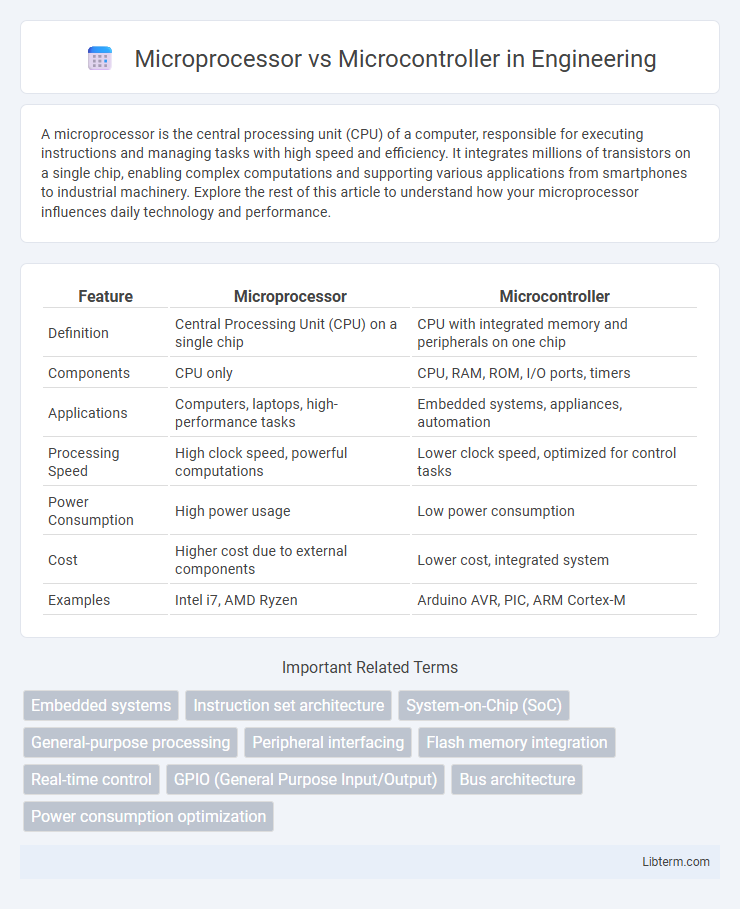A microprocessor is the central processing unit (CPU) of a computer, responsible for executing instructions and managing tasks with high speed and efficiency. It integrates millions of transistors on a single chip, enabling complex computations and supporting various applications from smartphones to industrial machinery. Explore the rest of this article to understand how your microprocessor influences daily technology and performance.
Table of Comparison
| Feature | Microprocessor | Microcontroller |
|---|---|---|
| Definition | Central Processing Unit (CPU) on a single chip | CPU with integrated memory and peripherals on one chip |
| Components | CPU only | CPU, RAM, ROM, I/O ports, timers |
| Applications | Computers, laptops, high-performance tasks | Embedded systems, appliances, automation |
| Processing Speed | High clock speed, powerful computations | Lower clock speed, optimized for control tasks |
| Power Consumption | High power usage | Low power consumption |
| Cost | Higher cost due to external components | Lower cost, integrated system |
| Examples | Intel i7, AMD Ryzen | Arduino AVR, PIC, ARM Cortex-M |
Introduction to Microprocessors and Microcontrollers
Microprocessors are central processing units (CPUs) designed to perform computation and control tasks by executing instruction sets, primarily used in personal computers and complex systems. Microcontrollers integrate a CPU, memory, and peripherals on a single chip, optimized for embedded systems and real-time applications. The key distinction lies in microprocessors requiring external components for functionality, whereas microcontrollers offer an all-in-one solution for dedicated control tasks.
Key Differences Between Microprocessors and Microcontrollers
Microprocessors consist primarily of a central processing unit (CPU) and require external components for memory and input/output functions, making them ideal for complex computing tasks with high processing power. Microcontrollers integrate a CPU, memory (RAM and ROM), and programmable input/output peripherals on a single chip, which is optimized for embedded systems and real-time control applications. The key differences lie in architecture, application scope, power consumption, and cost, with microcontrollers excelling in low-power, compact, and cost-sensitive environments, while microprocessors support more demanding computing environments with higher clock speeds and extensive multitasking capabilities.
Architecture Comparison: Microprocessor vs Microcontroller
Microprocessors feature a complex architecture with a powerful central processing unit (CPU) and rely on external memory and peripherals for functioning, enabling high processing speeds suitable for general-purpose computing. Microcontrollers integrate the CPU, memory (RAM, ROM), and peripherals on a single chip, providing a compact and cost-effective solution for embedded systems with real-time control requirements. The microprocessor's architecture emphasizes performance and flexibility, while the microcontroller architecture prioritizes integration and energy efficiency.
Applications and Use Cases
Microprocessors are primarily used in complex computing systems such as personal computers, laptops, and servers where high processing power and multitasking capabilities are essential. Microcontrollers find extensive application in embedded systems, including automotive controls, home appliances, and IoT devices, where integrated peripherals and real-time processing are crucial for dedicated tasks. The choice between microprocessor and microcontroller depends on application requirements, such as processing speed, power consumption, and system complexity.
Performance and Processing Power
Microprocessors typically offer higher performance and processing power due to their advanced architectures and higher clock speeds, making them suitable for complex computing tasks. Microcontrollers integrate a CPU with memory and peripherals on a single chip, optimizing efficiency for embedded applications but with lower processing capabilities. The choice depends on application requirements, where microprocessors excel in computational intensity and microcontrollers prioritize real-time control with limited resources.
Memory and Storage Capabilities
Microprocessors primarily rely on external memory for data and program storage, allowing flexible expansion but requiring additional chips and complexity; they typically support larger memory capacities suitable for complex applications. Microcontrollers integrate on-chip memory, including flash, RAM, and EEPROM, providing compact, efficient storage solutions optimized for embedded systems with fixed memory requirements. This integration offers faster access speeds and reduces overall system cost and size compared to microprocessor-based designs.
Power Consumption and Efficiency
Microcontrollers typically consume less power than microprocessors due to their integrated peripherals and simpler architecture, making them ideal for energy-efficient, embedded applications. Microprocessors, designed for higher performance, often require external components and higher power supply, increasing overall energy consumption. Optimizing power efficiency in microprocessors involves advanced power management techniques, while microcontrollers inherently offer low-power operation suitable for battery-powered devices.
Cost Analysis: Microprocessors vs Microcontrollers
Microcontrollers typically offer a lower overall cost compared to microprocessors due to their integrated peripherals, memory, and input/output interfaces on a single chip, reducing the need for additional components. Microprocessors, designed for high-performance computing, often require external memory and peripheral chips, increasing the total system cost and complexity. Cost-effectiveness in microcontrollers makes them ideal for embedded applications and mass-produced consumer electronics.
Selection Criteria for Embedded Systems
Choosing between a microprocessor and a microcontroller for embedded systems hinges on factors such as processing power, integration, and cost. Microcontrollers offer integrated peripherals and memory, making them ideal for low-power, cost-sensitive, and real-time control applications. Microprocessors provide higher computational performance and flexibility but require external components, leading to increased system complexity and power consumption.
Future Trends and Developments
Microprocessors will increasingly integrate artificial intelligence capabilities and edge computing functionalities to meet the demands of advanced data processing and real-time analytics. Microcontrollers are evolving with enhanced connectivity options such as 5G and Wi-Fi 6E, enabling smarter IoT applications and more efficient power management. Emerging trends include the convergence of microprocessor and microcontroller technologies, fostering hybrid systems that combine high performance with low power consumption for next-generation embedded solutions.
Microprocessor Infographic

 libterm.com
libterm.com